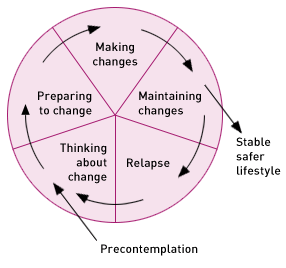Tackling volatile substance abuse in Scotland
a training course for the social care workforce
Course content: Intervention & referral
Helping young people at risk
When a family discover VSA this is frequently associated with fright, anger and confusion. Parents may be uncertain about how to react or what to say. Frequently this can be addressed with reassurance and the provision of basic information.
In many instances of solvent abuse the most relevant type of help is simple advice given in a straightforward and un-hectoring way and in terms intelligible to the young person.
More persistent use of volatile substances frequently occurs against the background of wider life difficulties or in the context of multiple behaviour problems. It may be of value to explore the background to the change in behaviour; the timing may be associated with other life difficulties such as bereavement. These individuals may need further support to help then to move away from solvents. This support may include practical assistance in helping them to address some of the wider issues in their lives.
Helping young people may involve supporting them to move through the process of change. The following are some of the characteristics of moving through the process of change:
- Learning the facts about the personal costs to their health and well being of their solvent abuse
- Realizing the burden and disappointment one puts on family, friends and society with the poor habit
- Getting emotionally charged with the prospect of making the change; recognizing one's abilities and past accomplishments that show the capacity to make the change
- Carefully considering how the behaviour started and why. Untangling this from guilt, shame, pride, and fear
- Making a deep commitment to the desired change
- Rewarding oneself appropriately for real progress in changing
- Knowing, recognizing and countering thoughts that keep one in the bad habit
- Stripping the environment of temptations as much as possible
- Arranging help and support from others

Prochaska and DiClemente (1992)
A model of understanding drug-using behaviour and the process of changing it that is used by many clinicians in the field to inform their practice is the Stages of Change Model proposed by Prochaska and DiClemente.1
'Motivational interviewing' is the name given to the use of interventions, designed using this model, to help people achieve change in the component behaviours of their drug dependence and/or abstinence. Many practitioners use other psycho-social and counselling approaches to help clients resolve problems in all areas of their life while using the stages of change model to understand the processes the person is going through in terms of their drug use.
There are many opportunities for interventions and counselling is not the only way forward. There can be many reasons why counselling is not an appropriate intervention, a young person may simply not want to be involved in an intense exploration of their life and motivations.
An important consideration is the participant's own expertise and job responsibilities. They obviously must only act within their professional boundaries, and they may be able to identify other professionals more suitable to take forward an intervention. Chronic VSA can have its roots in complex social issues and therefore the responses to their situation can also be complex.
As often happens, the best solution often occurs when professionals from different sectors work closely together. Other forms of intervention could include:
- Advocacy
If for example the individual is homeless - Diversionary activities
Anything which builds a feeling of self worth - Education
If they have limited social skills or are not aware of the facts - Community action
Often it is not only one individual involved and it may be important to provide a warning for other agencies and the wider community - Mentoring
The potential for such relationships to help young people review behaviour, develop resilience thus overcoming adverse life makes them attractive as interventions for policy makers wishing to turn around the lives of very disadvantaged or vulnerable young people2
West Lothian Education and Social Work departments funded a CSV project providing mentors to more than 50 young people in care, some of whom had become involved in criminal activity. Six full-time volunteers provided over 200 hours a week befriending time, helping them through everyday difficulties (see CSV Reports on Crime Reduction 2003).
Also in 2003 Lord Laidlaw set up the Laidlaw Youth Project, investing £2 million and working in partnership with the Scottish Government, to help vulnerable children and young people reach their full potential. Research published June, 2006 by the University of Edinburgh3 shows that social inclusion and strong bonds with adults (in the case of the study, teachers) are significant factors in young people giving up crime.
- Prochaska, J., DiClemente, C. & Norcross, J. (1992) ‘In search of how people change: applications to addictive behaviours’ American Psychologist vol. 47, pp. 1102-14. ↩
- CRFR Research Briefing (2005) Supporting Vulnerable Young People: Exploring planned mentoring relationships <http://www.crfr.ac.uk/Reports/rb19.pdf> viewed November 15 2007. ↩
- Smith, D. (2006), ‘Social Inclusion and Early Desistance from Crime’ Edinburgh Study of Youth Transitions and Crime vol. 12. ↩